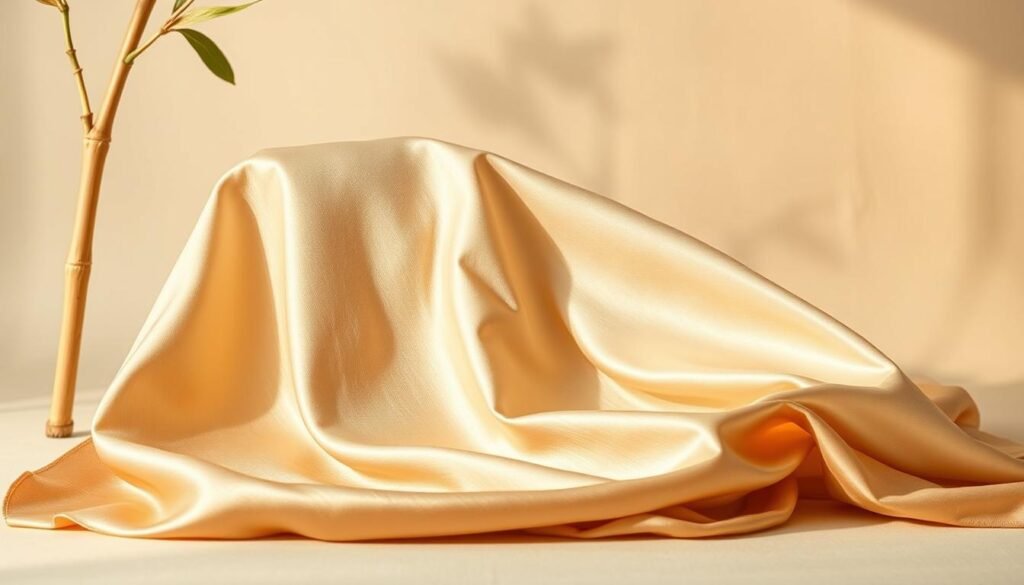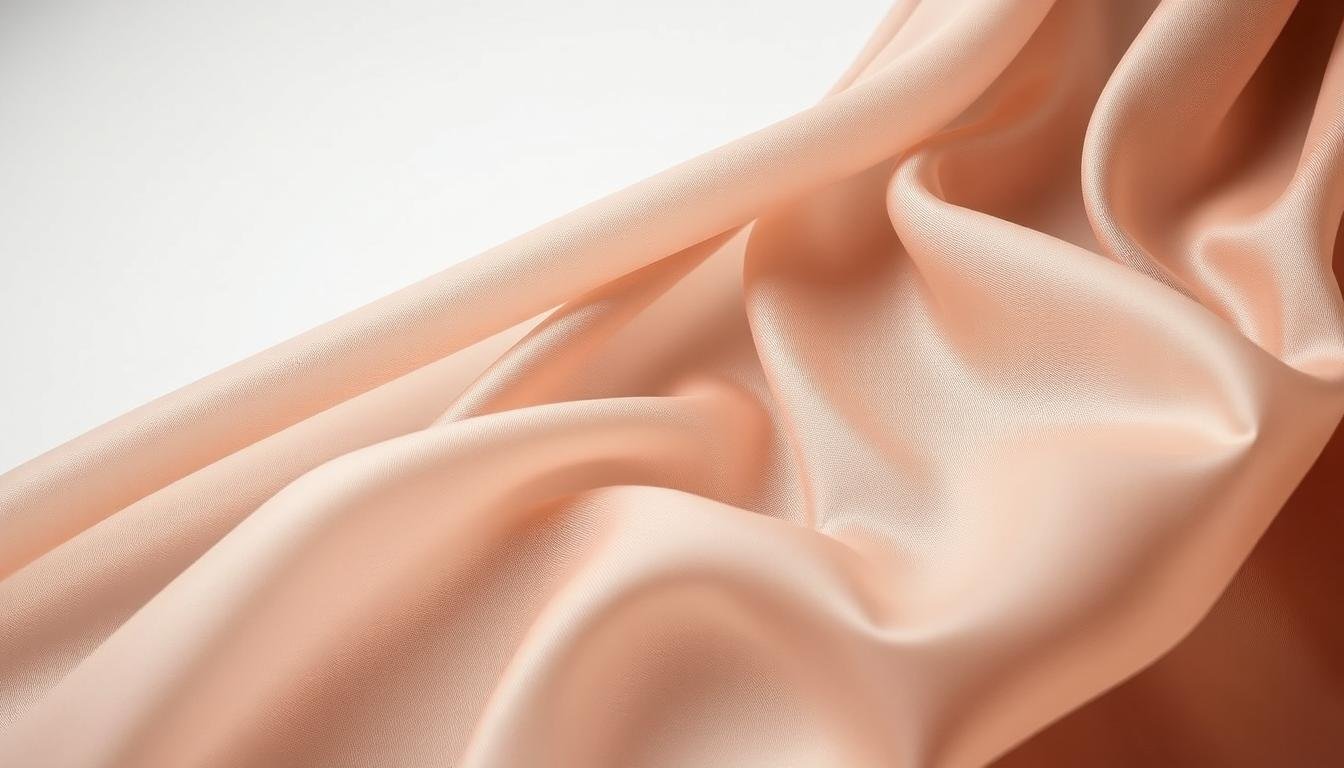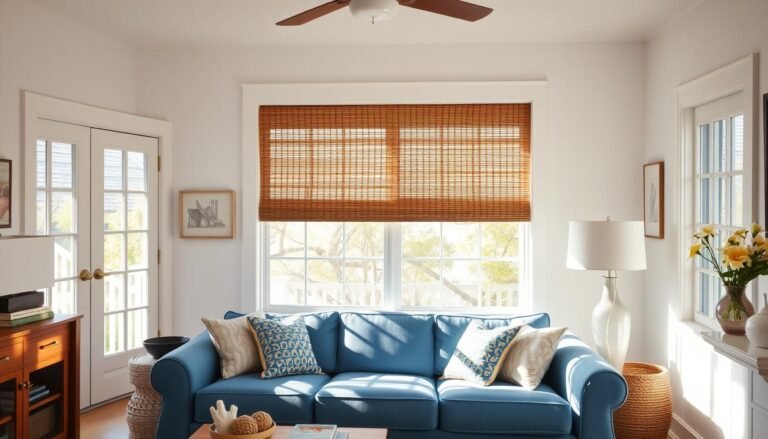Are you searching for a green option to traditional fabrics? Bamboo silk is becoming more popular for its eco-friendly qualities and soft feel.
We’re diving into the perks of bamboo fabric. It’s known for being soft, breathable, and has natural antimicrobial properties. This makes it perfect for clothes and home items.
As people care more about the planet, the need for sustainable textiles like bamboo silk is growing. Knowing what it’s all about helps us make better choices.
Key Takeaways
- Bamboo silk is a sustainable and eco-friendly textile alternative.
- It offers natural softness, breathability, and antimicrobial properties.
- Bamboo fabric is ideal for clothing and home textiles.
- The production of bamboo silk has a lower environmental impact.
- Bamboo silk is becoming increasingly popular among environmentally conscious consumers.
What is Bamboo Silk?
Bamboo silk is a special fabric that mixes silk’s softness with bamboo’s green benefits. It’s loved by those who care about the planet and want top-notch, eco-friendly items.
Definition and Production Process
Bamboo silk comes from bamboo fibers, turned into a soft, silky material. Making it involves steps like harvesting bamboo, turning it into pulp, and then making fibers. These fibers are woven into fabric, creating a luxurious, green material.
Creating bamboo silk is better for the environment than making traditional silk. Bamboo grows fast, needs little water, and no pesticides. This makes bamboo silk a great choice for eco-friendly fabrics.
How Bamboo Silk is Different from Other Silks
Bamboo silk stands out because it’s made in a way that’s kinder to the planet. Unlike traditional silk, which comes from silkworms, bamboo silk uses plant-based bamboo fibers. This makes it a better option for vegans or those with allergies.
Bamboo silk also has special properties. It’s incredibly soft, breathable, and keeps your body temperature just right. Plus, it’s durable and doesn’t wrinkle easily, making it great for clothes and bedding.
Key characteristics of bamboo silk include:
- Softness and luxurious feel
- Breathability and temperature regulation
- Hypoallergenic and vegan-friendly
- Durable and resistant to wrinkles
Key Benefits of Bamboo Silk
Bamboo silk is known for its comfort and eco-friendliness. It’s perfect for many uses, like clothes and bedding. Its benefits make it a top choice for many.
Softness and Comfort
Bamboo silk is exceptionally soft. It feels gentle on the skin, great for those with sensitive skin. Its softness rivals that of cashmere or silk.
- Provides a luxurious feel
- Ideal for sensitive skin
- Comparable to cashmere or silk in softness
Hypoallergenic Properties
Bamboo silk is known for being hypoallergenic. It fights off dust mites, mold, and mildew. This makes it perfect for those with allergies.
- Resists dust mites and other allergens
- Prevents the growth of mold and mildew
- Ideal for allergy sufferers
Temperature Regulation
Bamboo silk is great at regulating temperature. It keeps you cool in summer and warm in winter. This makes it great for all seasons.
In summary, bamboo silk is a top choice for comfort and sustainability. Its softness, hypoallergenic properties, and temperature control are unmatched. We suggest choosing bamboo silk for your next textile purchase.
Drawbacks of Bamboo Silk
Bamboo silk has many benefits, but it also has some downsides. It’s important to know these to understand its value and use. Let’s look at what might make you think twice about bamboo silk.
Potential for Wrinkling
Bamboo silk can wrinkle easily. This can make it look less polished after washing or wear. To fix this, some makers use special treatments or mix it with other fabrics.
Limited Color Range
Bamboo silk has a limited color palette compared to other fabrics. This is because of bamboo’s natural fibers and dyeing challenges. While natural colors are nice, others might find the lack of colors a drawback.
Price Comparison with Other Fabrics
Bamboo silk products are often more expensive than others, including some synthetic ones. This is because of the high-quality bamboo cost, complex making process, and eco-friendly efforts. Yet, its durability and long life might make it worth the extra cost.
When looking at prices, remember bamboo silk’s comfort, green benefits, and health perks. For many, these benefits make up for the higher cost.
Price Ranges of Bamboo Silk Products
The cost of bamboo silk items varies a lot. This is because of different production methods, material quality, and brand reputation. So, you can find bamboo silk products at many prices, from cheap to very expensive.
High-End vs. Budget Options
Bamboo silk products come in two types: affordable and luxury. The cheaper ones use simpler production methods. The more expensive ones have better materials and craftsmanship.
A basic bamboo silk pillowcase might cost around $20. But, a high-end bamboo silk bedding set could be over $200. Here’s a table showing the price ranges for different bamboo silk items:
| Product | Budget-Friendly | Luxury |
|---|---|---|
| Pillowcase | $20-$30 | $50-$70 |
| Bedding Set | $50-$80 | $200-$300 |
| Clothing | $15-$30 | $50-$100 |
Factors Affecting Pricing
Many things affect the price of bamboo silk products. These include production methods, material quality, brand reputation, and certification. Knowing these can help you choose wisely.
Production Methods: Using eco-friendly methods, like organic bamboo and non-toxic dyes, can make products more expensive. But, it also makes them more sustainable.
Material Quality: The quality of bamboo and how it’s made greatly affects the price. Better materials and craftsmanship mean higher costs.
Brand Reputation: Well-known brands that are known for quality and sustainability might charge more. This is because people trust and value their brand more.
Durability and Longevity of Bamboo Silk
Bamboo silk is known for its amazing durability and resistance to wear. It’s perfect for clothes and textiles that need to last. We’ll look at what makes it durable and give tips on caring for bamboo silk to make it last longer.
Wear and Tear Resistance
Bamboo silk is very strong and can handle a lot of wear and tear. Its smooth fibers help prevent pilling or snagging. So, bamboo silk clothes stay soft and in shape even after many washes and wears.
Key factors contributing to bamboo silk’s wear and tear resistance include:
- The natural strength of bamboo fibers
- The silk production process, which aligns the fibers for added durability
- The fabric’s breathability, which reduces moisture buildup and prevents damage
Care Tips for Longevity
To keep bamboo silk products in great shape, it’s important to care for them right. Here are some tips to help you take care of your bamboo silk items:
- Wash bamboo silk garments in cold water using a mild detergent.
- Avoid machine drying; instead, gently squeeze out excess water and air dry.
- Iron bamboo silk on a low setting, using a pressing cloth to prevent scorching.
- Store bamboo silk items in a cool, dry place, away from direct sunlight.
By following these care tips, you can enjoy your bamboo silk products for a longer period.
| Care Method | Benefit |
|---|---|
| Cold water washing | Preserves fiber strength |
| Air drying | Prevents shrinkage and damage |
| Low-temperature ironing | Maintains fabric smoothness |
Sustainability and Eco-Friendliness
More people are thinking about the planet, and bamboo silk is a top pick. It’s a fabric that’s good for the earth. Bamboo silk leads the way in eco-friendly fashion.
Bamboo as a Sustainable Resource
Bamboo grows fast and doesn’t need harmful chemicals. It’s ready to harvest in just three to five years. This is much quicker than traditional wood pulp, which takes decades.
Key benefits of bamboo include:
- High yield with minimal environmental impact
- Requires less water compared to many other crops
- Enhances soil quality and prevents erosion
Biodegradability of Bamboo Silk
Bamboo silk is made from a green resource and breaks down easily. It can decompose naturally without harming the environment.
| Feature | Bamboo Silk | Traditional Silk |
|---|---|---|
| Biodegradability | Yes | No |
| Renewable Resource | Yes | No |
| Environmental Impact | Low | High |

Choosing bamboo silk helps the planet. It supports green farming and lessens our environmental harm. Bamboo silk is a top choice for those wanting to help the earth.
Bamboo Silk vs. Cotton
In the world of textiles, bamboo silk and cotton are often compared. They are judged on comfort, sustainability, and cost. Let’s look at their differences to see which is better for us.
Comfort and Feel
Bamboo silk is very soft and feels luxurious. It’s like high-quality silk but cheaper. Cotton is natural, breathable, and comfy. But it’s not as soft as bamboo silk, mainly in lower thread counts.
Bamboo silk is more breathable and wicks moisture better. This makes it great for active wear. Cotton is breathable too but can hold more moisture. This can make it less comfy in hot weather.
Environmental Impact
Bamboo silk and cotton have different environmental effects. Bamboo grows sustainably, needing less water and pesticides. Bamboo silk production turns bamboo into fibers through a chemical process. This makes the fabric biodegradable.
Cotton is natural and biodegradable but uses more water and pesticides. Organic cotton is better for the environment but costs more.
Cost Comparisons
Cotton is usually cheaper than bamboo silk, mainly for basic items. Bamboo silk is pricier because of its production and quality. But, its durability and comfort make it a better value over time.
It’s important to consider the long-term benefits. Bamboo silk may cost more upfront. But its durability and comfort offer better value in the long run.
Bamboo Silk vs. Polyester
Choosing the right fabric is important. We’ll look at bamboo silk and polyester. We’ll compare their durability, breathability, and cost to help you decide.
Durability and Maintenance
Bamboo silk is strong and lasts long. Polyester is durable but can pill and not last as long. Bamboo silk is easy to care for, machine washable, and may need ironing. Polyester is also easy to wash but needs special care to stay good.
Key differences in durability and maintenance:
- Bamboo silk: Resistant to wear and tear, machine washable, may require ironing.
- Polyester: Generally durable, prone to pilling, easy to wash and dry.
Breathability
Bamboo silk is very breathable. It keeps you cool and dry. Polyester can be breathable but not as much as bamboo silk. Bamboo silk is better for comfort and keeping you cool.
Breathability comparison:
| Fabric | Breathability Level | Moisture Wicking |
|---|---|---|
| Bamboo Silk | High | Excellent |
| Polyester | Moderate | Variable |
Cost Analysis
Bamboo silk is pricier than polyester. It’s made naturally and sustainably. Polyester is cheaper because it’s synthetic. But bamboo silk lasts longer, making it a better value.
Cost comparison:
| Fabric | Average Price Range | Long-Term Value |
|---|---|---|
| Bamboo Silk | $20-$50 | High |
| Polyester | $10-$30 | Moderate |

Pros and Cons of Bamboo Silk
Bamboo silk is soft and eco-friendly, but it has downsides too. Knowing both sides helps us see its value as a green fabric choice.
Advantages Overview
Bamboo silk shines with many benefits. Here are some key ones:
- Softness and Comfort: It’s super soft, great for clothes and bedding.
- Breathability: It lets air flow well, keeping you comfy all year.
- Hypoallergenic Properties: It’s kind to sensitive skin, lowering allergy risks.
- Sustainability: Bamboo grows fast, needing less water and pesticides than many crops.
These perks make bamboo silk a top pick for those who want comfort and care for the planet.
Disadvantages Overview
Bamboo silk also has some downsides. The main ones are:
- Potential for Wrinkling: It can wrinkle a lot, needing more care than some fabrics.
- Limited Color Range: It might have fewer colors at first, but dyeing tech is getting better.
- Higher Cost: Making bamboo silk is pricier, so it costs more than some fabrics.
Knowing these downsides helps us make better choices when buying.
| Characteristics | Bamboo Silk | Traditional Silk |
|---|---|---|
| Softness | High | High |
| Breathability | Excellent | Good |
| Sustainability | High | Low |
| Cost | Moderate to High | High |
By looking at both sides of bamboo silk, we can see its special benefits and its limits.
Frequently Asked Questions about Bamboo Silk
Exploring bamboo silk raises many questions. We’ll answer some common ones to help you understand this eco-friendly fabric better.
Softness of Bamboo Silk
Bamboo silk is known for its softness. It’s a favorite for clothes and bedding. The natural fibers feel gentle on your skin, keeping you comfortable all day.
Care Instructions for Bamboo Silk
To keep bamboo silk in top shape, wash it gently. Don’t use harsh detergents or too much heat. This care helps your bamboo silk last longer.
Eco-Friendliness of Bamboo Silk
Bamboo silk is good for the planet. It’s made from bamboo, a renewable resource. The production process is also eco-friendly. Choosing bamboo silk helps the environment.
FAQ
What is bamboo silk, and how is it produced?
Bamboo silk is a fabric made from bamboo fibers. These fibers are harvested, processed, and woven into a soft material. The process starts with harvesting bamboo, then breaking it down into pulp. This pulp is turned into fibers that are woven into fabric.
Is bamboo silk soft?
Yes, bamboo silk is very soft and comfortable. Its natural fibers make it gentle on the skin. This makes it perfect for clothes and bedding.
How do I care for bamboo silk products?
To care for bamboo silk, wash it in cold water. Use a gentle cycle. Dry it on a low heat setting or air dry. This keeps the fabric soft and long-lasting.
Is bamboo silk eco-friendly?
Yes, bamboo silk is eco-friendly. Bamboo grows quickly and needs little water and pesticides. Making bamboo silk also has less environmental impact than traditional silk or synthetic fabrics.
How does bamboo silk compare to cotton in terms of comfort and environmental impact?
Bamboo silk is softer and more breathable than cotton. It also has a lower environmental impact. Bamboo grows sustainably and uses less water than cotton.
Can bamboo silk be used for bedding and clothing?
Yes, bamboo silk is great for bedding and clothing. It’s soft, breathable, and keeps a comfortable temperature. This makes it perfect for a variety of uses.
Is bamboo fabric the same as bamboo silk?
While similar, bamboo fabric and bamboo silk are not exactly the same. Bamboo fabric can include blends or other types of bamboo textiles. Bamboo silk, on the other hand, is made from bamboo fibers processed to feel silky.
What are the benefits of using bamboo material for clothing and textiles?
Bamboo material is sustainable, breathable, soft, and regulates temperature well. These qualities make it ideal for eco-friendly and comfortable clothing and textiles.




